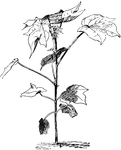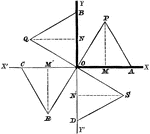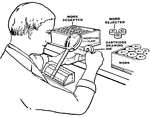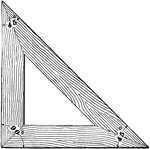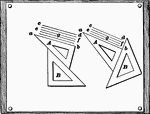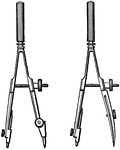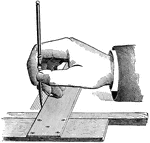
Corn Plant
Corn plants with the surface of the soil "laying by" in accordance to the Williamson Plan.

Hinds Chain Cultivator
A Hinds chain cultivator that is used for tillage and drawing fallen squares to water furrow.

Plows for Sweet Potato Harvesting
Plows used to dig sweet potatoes. "The long vines must be first disposed of. They are usually pulled…
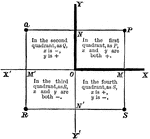
Coordinate Plane
A coordinate planes with the quadrants labeled showing which value (x or y) is positive or negative.
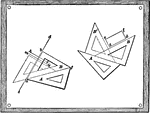
Mechanical Drawing Exercise
Drawing perpendicular lines using a drawing board and pairs of triangles.
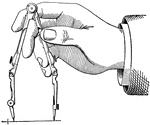
Hand Holding a Drafting Compass
A hand holds and employs a drafting compass, a device used to create precise arcs and circles in mechanical…

Sunflower Corner Motif, Right
Drawing of three sunflowers arranged for use as top right corner decoration.

Pompeii Graffiti from the House of Dioscuri - Gladiator Holding Palm Leaf
A drawing of one section of the graffiti found on the house of Dioscuri in Pompeii. A gladiator descends…
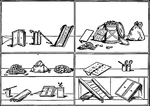
Roman School Materials - Based on a Wall Painting from Pompeii
An illustration of a Pompeiian wall painting of school materials, including scrolls, books, writing…

Hun Warrior on Horseback in Battle
Illustration of a Hun warrior riding on horseback, his mouth open as if to scream. The warrior has a…
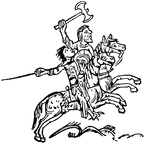
Two Anglo-Saxon Warriors on Horseback
Illustration of a drawing in The Harley Psalter, an illuminated manuscript of the second and third decades…

Threshing Wheat with Flails in the 14th Century
Two men thresh a sheaf of wheat using flails. The flails appear to be made from two sticks joined together…

A German Town on the Main River, Possibly Würzburg
Illustration of a town in Germany during the late Middle Ages, or medieval period. The town sits on…
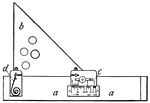
Section Liner, A Draftsman's Tool
"A draftsman's instrument for ruling parallel lines. It consists of a triangle so attached to a straight-edge…
![Drawing of the Diana of Versailles, a 2nd-century Roman version in the Greek tradition of iconography. In Roman mythology, Diana ([djana]) was the goddess of the hunt, the moon and childbirth, being associated with wild animals and woodland, and having the power to talk to and control animals.](https://etc.usf.edu/clipart/188200/188203/188203-diana-of-versailles_mth.gif)
Diana of Versailles
Drawing of the Diana of Versailles, a 2nd-century Roman version in the Greek tradition of iconography.…
Bobsled - Side View
"A pair of runners connected by a framework, used (sometimes with another pair) to carry loads or support…
Hand Sled
"A pair of runners connected by a framework, used (sometimes with another pair) to carry loads or support…

Hand Sled or Sledge
"1. A drag or dray without wheels, but mounted on runners, for the conveyance of loads over frozen snow…
